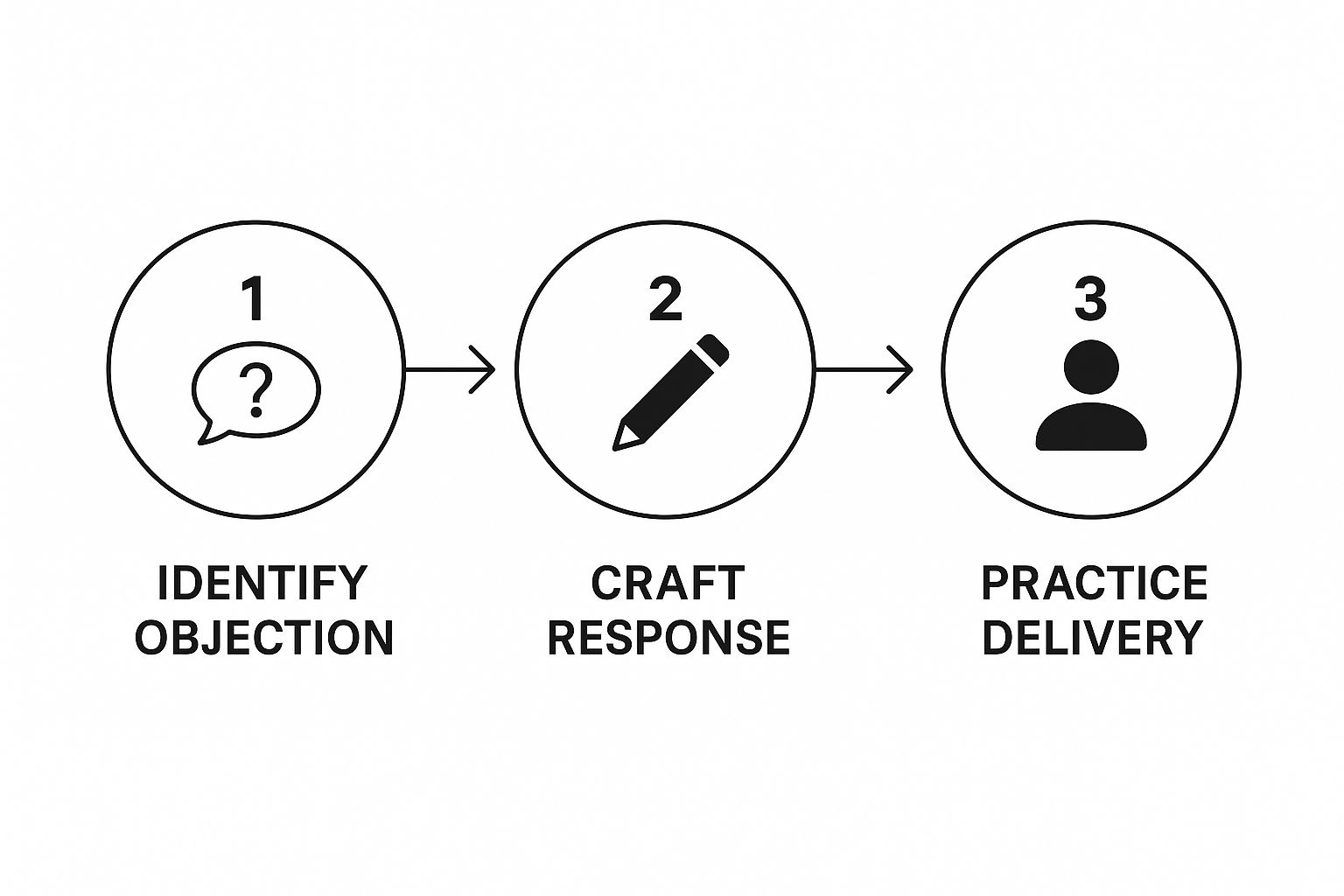Why Most People Get Objections Completely Wrong

Let's start by changing how we look at sales objections. So many sales guides paint them as a fight you need to win or a roadblock to clear. But what if they’re not a sign of failure? What if they're actually a signal that your prospect is paying attention? This is the main reason most people get handling sales objections all wrong—they see conflict when they should be seeing curiosity.
Seasoned sales pros don’t run from objections; they lean into them. An objection means your prospect is thinking deeply about what you're offering, enough to poke holes in it. The real enemy in sales is apathy. A silent prospect is far more worrying than one questioning your price, because silence gives you nothing to work with. Objections are an open invitation to talk more, revealing what’s actually important to the person you're speaking with.
The Psychology Behind Resistance
Figuring out why a prospect is pushing back is the first real step. The resistance you feel is almost never personal. It usually comes from a few core human emotions we can all relate to:
- Fear: The worry of making a wrong choice, looking silly in front of their team, or dealing with the fallout from a bad purchase.
- Uncertainty: They simply don't have all the facts yet. The value you're offering hasn't clicked enough to outweigh the cost or the hassle of making a change.
- Social Pressure: They might need to sell this decision to their boss, a committee, or a business partner. Your prospect's objection could be them testing you to see if you can give them the ammunition they need to defend their choice internally.
When you realise you’re not in a debate but are actually helping someone work through these very normal pressures, your entire tone changes. You stop trying to prove a point and start working together to find a solution.
Persistence Is Part of the Process
This mental shift from confrontation to collaboration isn't just a nice idea; it's backed by real numbers. Pushing back is just a standard part of how people buy things now. One insightful study showed that 60% of customers say "no" four times before they finally say "yes." On top of that, 80% of sales require an average of five follow-ups to close.
This tells us that the first "no" is rarely the final word. It's more like a checkpoint. The best in the business understand this. They use every interaction to build more trust and show more value, rather than just pushing for a quick sale. You can explore the complete study on the hidden science of sales to get a better sense of how important it is to stick with it.
The LAER Method: Your Universal Response System
Instead of trying to memorise a different script for every possible pushback, imagine having a single, reliable framework for handling sales objections. This is exactly what the LAER method provides. It’s a four-part system—Listen, Acknowledge, Explore, and Respond—that gives you a dependable structure for any conversation, turning potential confrontations into collaborative problem-solving. It’s less about having the perfect line and more about having the perfect process.
Listen and Acknowledge
The first two parts, Listen and Acknowledge, are your secret weapons for disarming tension right away. When a prospect raises a concern, our gut reaction is often to jump in and defend our product. You have to fight that urge. Instead, Listen to everything they have to say without interrupting. Giving them the floor shows respect and, just as importantly, stops you from guessing what they really mean.
Once they've finished, Acknowledge their perspective with a simple, neutral statement. This doesn't mean you agree with them. It just shows you've heard them. You could say something like, "Okay, I can definitely see why budget is a top concern for you," or "That makes perfect sense; you need to be sure this will work with your current system." This small act of validation lowers their defences and makes them much more open to what comes next.
Mastering this approach has a real impact. In fact, research shows that sales reps who effectively handle buyer objections can boost their close rates to as high as 64%. You can read more about these sales objection findings and see how this directly affects your bottom line.
Explore and Respond
Now that the prospect is more receptive, it’s time to Explore. This is your chance to uncover the real issue hidden beneath their initial comment. Use open-ended questions to dig a little deeper. For instance, if the objection is, “It’s too expensive,” you could ask, “When you say expensive, could you help me understand what you're comparing it to?” This question shifts the conversation from a dead-end price complaint to a meaningful discussion about value.
The infographic below shows how this process flows from identifying the issue to crafting a thoughtful response.

As the visual shows, having a repeatable process is the foundation for consistent success. Finally, you Respond. Because you now have a genuine understanding of their core concern, your response will be laser-focused and much more effective than any generic script. It's tailored to what you learned during the Explore phase. For field sales teams, keeping these conversations organised is vital, making a dedicated system a must-have. You can check out our guide on getting started with LeadFlow Manager to see how it can help.
To make this even more practical, let's break down how to apply the LAER framework to the most common types of objections you'll face in the field.
LAER Framework Application by Objection Type
A detailed breakdown of how to apply Listen, Acknowledge, Explore, Respond techniques for different categories of sales objections
table block not supported
By using this table as a guide, you can start to see how the LAER framework isn't just a theory—it's a practical tool that adapts to any situation you encounter.
Building Scripts That Sound Like Real Conversations

Let's be honest, the word "script" can make any salesperson's skin crawl. It brings to mind stilted, robotic lines that sound completely unnatural. But a good script isn’t about reading from a page; it's about building a conversational safety net. Think of it more like a flexible framework of talking points, not a rigid screenplay. This preparation means you're never caught flat-footed and can confidently navigate the tricky parts of handling sales objections. The real goal is to internalise the logic so the words come out sounding like you.
In Canada, this is seen as a key business practice. Many experts suggest creating guides for common objections around price, timing, or product fit, based on what you hear from customers time and again. This preparation helps you respond professionally and consistently. You can discover more insights on handling objections with a professional approach at ca.indeed.com.
From Rigid Lines to Flexible Frameworks
The most useful "scripts" are never meant to be read aloud. Instead, they’re designed around a few core ideas that you can adapt to fit any real-world conversation. This method lets you keep your authentic voice while ensuring you cover the most critical points.
Here's a simple way to build your own response frameworks:
- Acknowledge and Validate: Always start by showing you’re actually listening. Something as simple as, "I hear that completely," or "That's a very fair point," can instantly lower their guard.
- Pivot with a Question: Gently turn the conversation from their concern back toward value. A casual, "Could I ask a quick question about that?" works beautifully.
- Provide a Value Nugget: Share a brief, impactful piece of information that addresses their objection without sounding argumentative. For a price objection, you could mention a client who achieved a specific, impressive return on their investment.
- Confirm Understanding: Always check in to keep it a two-way street. "Does that make sense?" or "How does that sound to you?" keeps the dialogue collaborative and prevents it from becoming a lecture.
Practising for Spontaneity
Once you have these frameworks ready for the usual objections, the next step is practice. You need to run through them until they feel second nature. Role-play with a colleague, record your responses on your phone, or just talk them through while you’re driving. The objective isn't to memorise every word, but to become so familiar with the flow that you can deliver the core message naturally. The best scripts are the ones that don't sound like scripts at all—they sound like a helpful expert thinking on their feet.
Mastering Price, Authority, And Timing Objections
While every sales conversation feels different on the ground, the objections you face often follow a familiar script. They usually fall into a few predictable buckets, with price, authority, and timing being the big three. Think of these as the classic hurdles you can see coming from a distance—which is good news, because it means you can prepare to clear them. Learning how to navigate handling sales objections starts with understanding what these common pushbacks are really about.
Reading Between The Lines of Common Objections
Let’s be honest: when a prospect tells you, "Your price is too high," what they often mean is, "I don't see enough value yet to justify this cost." It's rarely a simple math problem; it's a value perception gap. Likewise, hearing "I need to check with my boss" might be true, but it can also be a shield to avoid a decision they're nervous about. Their hesitation isn't just about the org chart; it's about personal risk.
Timing objections like, "Call me back next quarter," are especially tricky. This could be a polite way of saying "no," or it could point to real concerns about their current budget cycle or shifting internal priorities. Your job isn't to take these statements at face value but to gently dig into what’s happening behind the scenes. A good diagnostic question can turn a dead-end into a productive conversation.
For a timing objection, you might ask, "I understand completely. Just so I'm better prepared for our next chat, what are the key priorities your team is focused on this quarter?" This simple question can reveal whether their plate is genuinely full or if your solution just hasn't connected with their most pressing needs.
Strategies For Each Major Objection Type
Responding effectively requires a specific approach for each type of objection. For price, the last thing you want to do is offer a discount right away, as it just devalues your offering. Instead, re-centre the conversation on the return on investment (ROI). You could say, "I hear you. Many of our most successful clients felt the same way at first. But they found that by solving [specific problem], they actually saved money in the long run. Could we explore what that might look like for your business?"
When faced with an authority objection, your goal is to turn your contact into an internal champion. Equip them with the information they need to confidently present your case to their superiors. Ask them, "That makes total sense. What's the most important information I can give you to help with that conversation with your boss?" This reframes you as a helpful partner, not just another salesperson. By addressing the root cause—whether it’s a value gap, decision anxiety, or a priority mismatch—you keep the dialogue moving forward instead of letting it stall.
To help you organise your approach, the table below breaks down these common objections, what's really behind them, and how you can start to tackle them more effectively.
Objection Types and Effective Response Strategies
Comparison of the most common sales objections with proven response techniques and success indicators
table block not supported
This table shows that the initial objection is rarely the final word. By understanding the concern behind the objection, you can choose a response that builds trust and keeps the conversation alive. The key is to shift from defending your price or timeline to partnering with the prospect to solve their underlying problem.
Decoding What Prospects Actually Mean When They Object
The real skill in handling sales objections isn't about having the perfect comeback; it's about truly listening to what's being said—and what isn't. Experienced sales reps understand that a prospect's initial objection is often a smokescreen for a deeper concern. Learning to translate these common pushbacks is like having a secret decoder ring for sales; it allows you to address the root of the problem, not just the surface-level symptom.
For instance, when a prospect tells you, “Your price is too high,” they’re rarely just talking about the number. More likely, it’s code for, “I don’t see how the value justifies the cost,” or “I’m not confident I can get this expense approved.” In the same way, a vague brush-off like, “Just send me some information,” is often a polite escape hatch to avoid a real conversation. The trick is to stop taking these statements at face value and start digging into what’s really behind them.
Reading the Room: Real Concerns vs. Automatic Responses
It's vital to figure out if you're dealing with a genuine concern or just a knee-jerk reaction. Many prospects have a go-to "no" they use to deflect salespeople, a common tactic in scenarios like door-to-door sales where initial resistance is high. Your job is to gently probe past this default setting.
- Real Concerns: These are specific and tied to a real business challenge. A prospect might say, “We tried a similar product last year, and the onboarding process was a disaster for our team.” This gives you a concrete problem you can help solve.
- Automatic Responses: These are generic and non-committal, such as, “We’re happy with our current provider.” They're often a sign that you haven't built enough rapport or demonstrated enough value to earn a deeper dialogue.
A great technique to see what you're up against is to ask thoughtful, clarifying questions. When you hear, “This isn’t a priority for us right now,” a good follow-up is, “That makes sense. Can I ask what your biggest priorities are for this quarter?” This simple question can shift the conversation from a dead end to a genuine discussion. Mastering this skill is a game-changer for field teams. In fact, we dive deeper into this in our guide on succeeding in door-to-door sales. By listening for the why behind the what, you begin to solve your prospect's actual problems instead of just fighting their objections.
Advanced Prevention And Follow-Up Strategies
The best way to handle sales objections is to get ahead of them. This isn't about being slick or pulling a fast one; it's about building such a convincing case for your solution that common objections don't even seem relevant by the end of your pitch. You're essentially planting seeds of value along the way. Instead of bracing for a price objection, you casually mention how another client achieved a 30% reduction in operational waste within six months. This move reframes the cost as a smart investment before they can label it as just another expense.
Experienced sales pros seem to have a sixth sense for what a prospect is thinking. This comes from paying close attention to industry chatter and customer behaviour. For instance, if you know a particular sector is tightening its belt due to budget cuts, you should open with your solution's cost-saving features, not its fancy growth tools.
Turning Objections Into Opportunities
Knowing when to tackle a concern is as critical as knowing how. If a prospect asks a minor technical question early on, it’s often best to acknowledge it, park it for later, and keep building the bigger picture. This stops you from getting sidetracked by small details before the person even gets why your solution matters to them.
On the other hand, if a major roadblock appears—like them not being the final decision-maker—you have to address it immediately. Dodging a core issue can make you look like you lack confidence. Instead, use it as a chance to strengthen your connection. You could say, "That's a great point. To make sure we get this right, what are the key metrics your manager will be looking at? Let's work together to build a business case they can't possibly say no to." This changes a potential dead-end into a team effort, positioning you as a partner, not just another vendor.
Smart Follow-Up And Continuous Improvement
So what do you do when the "no" is final? Your follow-up game needs to be on point. Even a tough conversation doesn't have to be the end of the relationship. Keep your tone positive and helpful, and always leave the door open for the future.
The real key is to track these interactions. If you keep hearing the same objection from a specific type of lead, that’s gold. It’s direct feedback telling you precisely where your pitch needs work or how you might need to adjust your approach for that segment. For companies with teams in the field, refining this process can be a game-changer. By systematically tracking and learning from resistance, you create a stronger, more resilient sales strategy that actually uses objections to fuel growth.
Your Personal Objection Handling Toolkit
Let's get practical. Understanding the theory behind handling sales objections is one thing, but using it when you're face-to-face with a skeptical prospect is another entirely. The goal here is to build your own toolkit, a system that makes your best responses feel natural and immediate. This isn't about memorising scripts; it's about being so well-prepared that your confidence and authenticity shine through in every interaction.
Your first move is to create an objection playbook. Open up a document and list the top five objections you constantly run into in your line of work. For each one, draft a flexible framework for your response—think guideposts, not a rigid script. A great model to follow is the LAER method: How will you Listen and Acknowledge? What questions will you ask to Explore? How will you Respond?
Practice That Actually Prepares You
With your frameworks ready, it’s time to practice. Just reading them over isn’t going to cut it when you’re under pressure. You need active, structured role-playing to truly ingrain these skills.
- Find a Sparring Partner: Ask a colleague to be your practice partner. Tell them to throw realistic objections at you and not to hold back. You want to feel a bit of the pressure you'd experience in a real sales conversation.
- Record Yourself: It might feel a bit awkward, but use your phone to record your practice sessions. Listening to the playback is the quickest way to catch hesitation in your voice, identify filler words, or notice missed opportunities to steer the conversation.
- Focus on One Objection at a Time: Don't overwhelm yourself by trying to tackle every objection at once. Dedicate a full week to mastering price objections, for instance. That focused repetition is what builds real "muscle memory."
Tracking Your Growth
So, how can you tell if all this practice is paying off? By tracking your progress. After any sales call that involved an objection, take a couple of minutes to note down what the objection was, how you handled it, and what happened next.
Start looking for patterns. Are specific responses consistently leading to more productive conversations? Are you successfully turning more "I'll think about it" stalls into concrete follow-up meetings? This simple data becomes your personal feedback loop, showing you exactly what’s working. You'll know you're getting good when objections stop feeling like deal-killers and more like familiar steps on the path to closing.
For field sales teams trying to coordinate these efforts, a central system is crucial. A tool like LeadFlow Manager can bring structure to your sales activities on the go, making it easier to log interactions and manage your follow-ups so nothing gets missed. Discover how LeadFlow Manager can streamline your entire sales process today.
